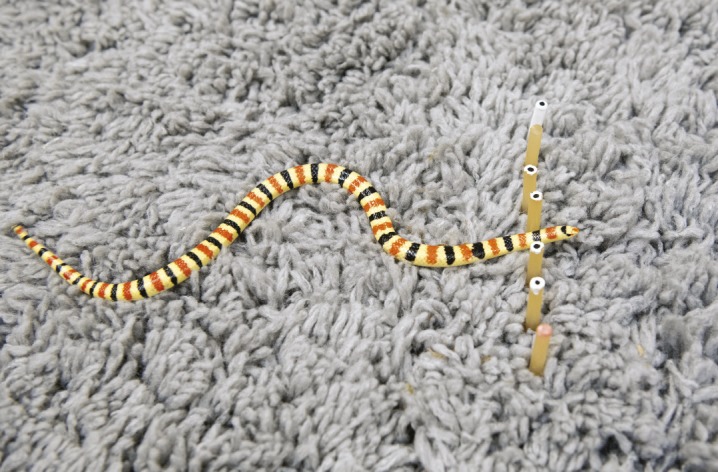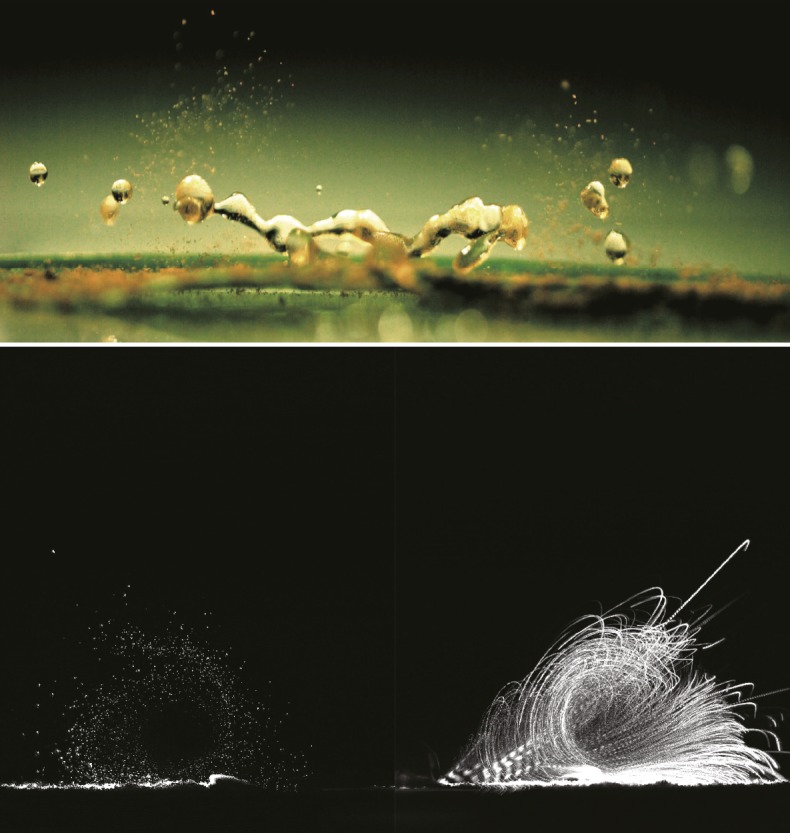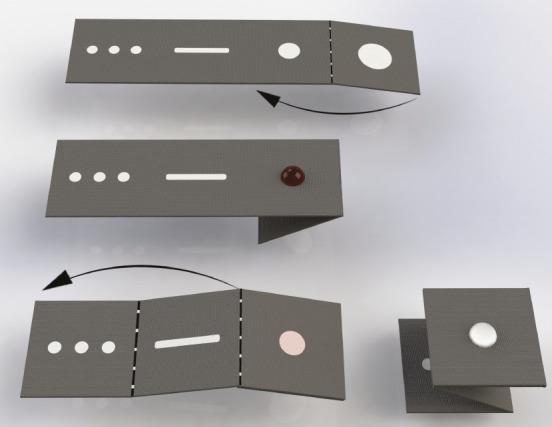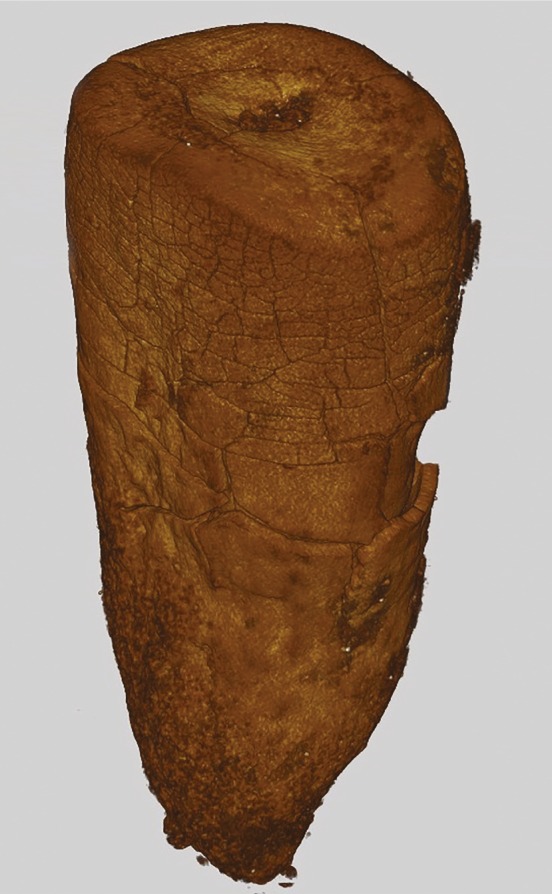Passive dynamics in snakes’ slithering motion

Shovel-nosed snake moves through force-sensitive rubber pegs. Image courtesy of Allison Carter (Georgia Institute of Technology, Atlanta).
Limbless vertebrates such as snakes slither across sandy surfaces by pressing the curves of their sinuous trunks against transient piles of sand to propel themselves forward. However, whether snakes use passive mechanics or fine motor control based on sensory input from the environment to navigate obstacle-strewn terrain remains unclear. Perrin Schiebel et al. (pp. 4798–4803) used high-speed video cameras to monitor the movement of the shovel-nosed desert snake (Chionactis occipitalis) across an experimental track affixed with six force-sensitive posts; C. occipitalis normally uses a body-deforming sinusoidal wave to propel itself along sandy desert terrain. Analysis of 253 trajectories of eight snakes revealed that the snakes did not alter their self-deformation pattern or the waveform to avoid or grab the posts. Instead, the snakes maintained their motor program, relying on passive dynamics, which evoked the diffraction pattern of subatomic particles, to navigate without additional neural input. Modeling analysis revealed that muscle activation allowed the snakes to buckle around the posts. According to the authors, the findings suggest that incorporating principles of passive dynamics into the design of snake-like robots might improve their mobility in complex terrains. — P.N.
Deep learning, molecular dynamics illuminate Gaucher disease
The N370S mutation in GBA1—the gene encoding the enzyme glucocerebrosidase-1 (GCase)—accounts for around 70% of Gaucher disease, a devastating genetic disorder which can cause severe organ damage. Disruptions in GCase function cause the enzyme’s lipid substrates to accumulate, but the atomistic-level mechanisms by which mutations such as N370S degrade enzyme function remain unclear. Raquel Romero, Arvind Ramanathan, et al. (pp. 5086–5095) present a model of GCase in complex with its facilitator protein, saposin C (SAPC), constructed by applying deep learning to multiscale molecular dynamics simulations and structural bioinformatics. The model characterizes the complete GCase–SAPC protein–protein interface and reveals how SAPC activation of GCase evolves from an inactive substate through intermediate and active conformations. Based on the model, the authors demonstrate that N370S induces conformational changes that prohibit SAPC from interacting with GCase, whereas L444P, the second most common mutation associated with Gaucher disease, interferes with the flexible and evolving process by which SAPC activates the enzyme. The findings uncover precise mechanisms by which the two most common mutations tied to Gaucher disease disrupt GCase function, according to the authors. — T.J.
Childhood environments and mental health
Although living in urban environments is associated with increased risk of developing mental illnesses, there is a lack of longitudinal research on this phenomenon. To explore whether and how natural surroundings during childhood are associated with mental health, Kristine Engemann et al. (pp. 5188–5193) examined the psychological records of 943,027 people who were born in Denmark between 1985 and 2003 and still living in the country by their 10th birthday. The authors compared the records with satellite images from 1985 to 2013 that displayed the amount of vegetation surrounding each person’s residence. Compared with children who lived in areas surrounded by the greatest amount of vegetation, children who lived in areas surrounded by the least vegetation had up to 55% increased risk of developing a psychiatric disorder. Intellectual disabilities and schizoaffective disorder, however, were not positively associated with lack of access to nature. Approximately 50% of all psychiatric disorders were diagnosed in adulthood. The findings suggest that integrating natural environments into urban areas, especially near schools and other places where children congregate, may improve the mental health of urban residents. — M.S.
How raindrops disseminate plant pathogens

Vortex-induced pathogen dispersal upon impact.
Rainfall aids the spread of plant pathogens, such as fungal spores, across long distances. When rainfall splashes on surfaces, drops laden with rain-drenched spores and less than 100 µm in width can be carried by wind to susceptible plants. However, the precise mechanism by which large raindrops, which are too heavy to become airborne, mobilize dry spores upon hitting infected plant surfaces remains unclear. Seungho Kim et al. (pp. 4917–4922) used high-speed photography and modeling to visualize and compute how individual raindrops liberate and transport dry spores of the wheat rust fungus Puccinia triticina from infected wheat plants. Upon impact with the leaf surface, a single raindrop liberates thousands of dry dispersed spores, the number of spores increasing with impact velocity. Analysis revealed that the impact generates an air vortex ring around the raindrop that lasts for tens of milliseconds; the vortex ring, which increases the height to which the spores are ejected, sends the spores aloft in a swirling motion, exposing them to the wind and potentially enabling their transport away from leaf surfaces, beyond leaf boundaries, and across several kilometers. According to the authors, raindrop-induced air vortex rings may thus play a crucial role in the long-distance dry dispersal of plant pathogens. — P.N.
Origami-inspired rapid malaria field test

Paper-folding steps for fluidic manipulation.
Healthcare workers require low-cost, rapid field tests to help combat the spread of infectious diseases such as malaria. However, many existing tests have proven unsuitable for remote, rural communities that lack refrigeration and laboratory equipment. Julien Reboud, Gaolian Xu, et al. (pp. 4834–4842) describe a paper-based, origami-inspired field device that provides rapid, high-quality, species-specific malaria diagnostics that compare favorably to laboratory assays based on the polymerase chain reaction (PCR). Using a wax printer and hot plate, the design draws on previous work using origami folding techniques to create a paper-based device that prepares blood samples for loop-mediated isothermal amplification (LAMP), an accurate amplification technique that is more readily applicable in the field than PCR. The authors augmented the device with microfluidic lateral flow LAMP and a detection platform that can diagnose malaria species from a finger-prick blood sample. The study also presents a double-blind, first-in-human trial in rural primary schools in the Mayuge and Apac Districts of Uganda that demonstrate that the device outperforms other established techniques, detecting malaria in 98% of infected participants, according to the authors. — T.J.
Isotopic evidence of Neandertal carnivory

3D reconstruction of the les Cottés Neandertal tooth sampled in the study.
Neandertal remains contain high nitrogen isotope ratios. However, whether these ratios indicate a carnivorous diet is unclear, and previous studies have suggested specific sources of high nitrogen ratios, such as mammoth or putrid meat. Researchers previously discovered exceptionally high nitrogen isotope values in some Neandertal remains, traditionally interpreted as a signature of freshwater fish consumption. Klervia Jaouen et al. (pp. 4928–4933) conducted compound-specific isotope analyses of carbon and nitrogen isotopes in two samples of late Neandertal collagen, as well as in samples from associated animals to establish food web relationships. Isotopic analysis further assessed carbon-specific and nitrogen-specific isotope values for individual amino acids to further distinguish between food sources. Nitrogen isotope results supported the position of Neandertals within the food web as consumers of herbivores, and the high isotope ratios in bulk bone collagen could be explained by herbivore consumption alone, without additional food sources as previously suggested. Archaeological evidence supports reindeer hunting but not the consumption of freshwater fish, whereas carbon isotopes of bulk collagen do not support consumption of mammoths in one of the two sites studied. According to the authors, although the results do not rule out occasional consumption of other food sources, the Neandertal diet was likely carnivorous. — P.G.


